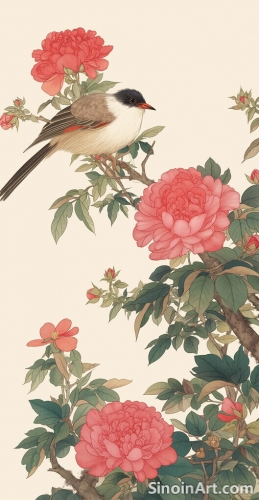Gongbi Painting as a Form of Meditation and Mindfulness
|
The creation of a Gongbi painting is a process that requires immense patience, focus, and attention to detail. This demanding process can be seen as a form of meditation and mindfulness, where the artist engages deeply with the present moment and allows their thoughts to quiet down. The act of creation becomes a contemplative experience that fosters a sense of calm and inner peace.  The slow and deliberate nature of Gongbi painting requires the artist to be fully present and engaged in the process. Every brushstroke, every layer of color, demands a high degree of concentration. This focused attention allows the artist to enter a state of flow, where time seems to disappear, and the artist is completely immersed in the act of creation. The focused work can be meditative for many artists.  The meticulous techniques of Gongbi painting, such as the careful outlining and the layering of colors, require a steady hand and a quiet mind. The artist must cultivate a sense of calm and inner stillness to maintain the precision and control necessary for these demanding techniques. The mental discipline required for the art fosters a meditative state.  The act of creating a Gongbi painting can also be seen as a form of contemplation on the subject matter. The artist is required to observe the natural world closely, paying attention to the intricate details and the subtle nuances of form and color. This process of observation can foster a deeper understanding of the subject and a greater appreciation for the beauty of the natural world. The deep observation becomes a form of meditation and respect for the subject matter. The process of creating art in this mindful way is not just a technical endeavor; it is also a spiritual one. The act of creation becomes a vehicle for self-discovery and a path to inner peace. The time and effort required to make the work is a gift that brings a sense of calm to both creator and viewer. Ultimately, the creation of Gongbi painting serves as a reminder of the power of focused attention and the value of being present in the moment. The art form encourages patience, mindfulness, and a deeper engagement with the world around us. The act of creation in this way is a form of meditation and contemplation. |
Tag : Gongbi meditation, mindful painting, art and mindfulness, meditative art, Chinese art therapy
Related information
- The Enduring Legacy of Gongbi Painting: Tradition and Innovation
- The Use of Perspective and Space in Gongbi Painting
- Commissioning a Gongbi Painting: What You Need to Know
- The Spiritual Aspects of Gongbi Painting
- Symbolism in Gongbi Painting: Reading the Language of Detail
Gongbi painting, rooted in the rich artistic traditions of imperial China, has proven to be an enduring and highly versatile art form, adapting and evolving across generations while maintaining its core principles of precision, detail, and symbolic depth. The long history of Gongbi painting continues to be influential on modern art and the appreciation of traditional techniques.
This article explores the use of perspective and space in Gongbi painting, highlighting how artists blend traditional approaches with modern techniques to create a sense of depth, distance, and visual dynamism.
This article provides a guide for those interested in commissioning a Gongbi painting, highlighting the importance of clear communication, artist selection, understanding the process, setting realistic timelines, and managing budget expectations.
An examination of the spiritual dimensions of Gongbi painting, highlighting its meditative qualities and connection to nature.
Gongbi painting is not only a visual art but also a rich tapestry of symbolic meanings, where the careful selection and rendering of subjects, colors, and compositional elements serve to convey specific messages and cultural values. The meticulous detail, characteristic of the style, enhances the symbolic weight of each object, transforming a seemingly realistic depiction into a complex visual language. This symbolic richness adds layers of meaning to the artistry of Gongbi painting.